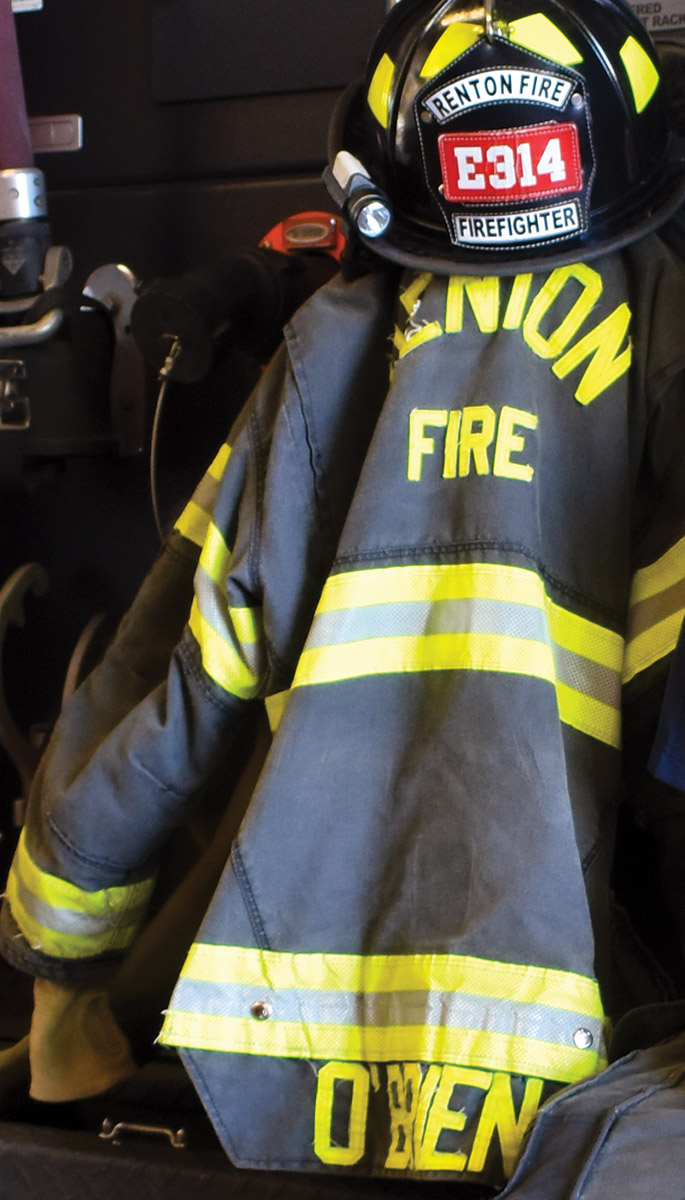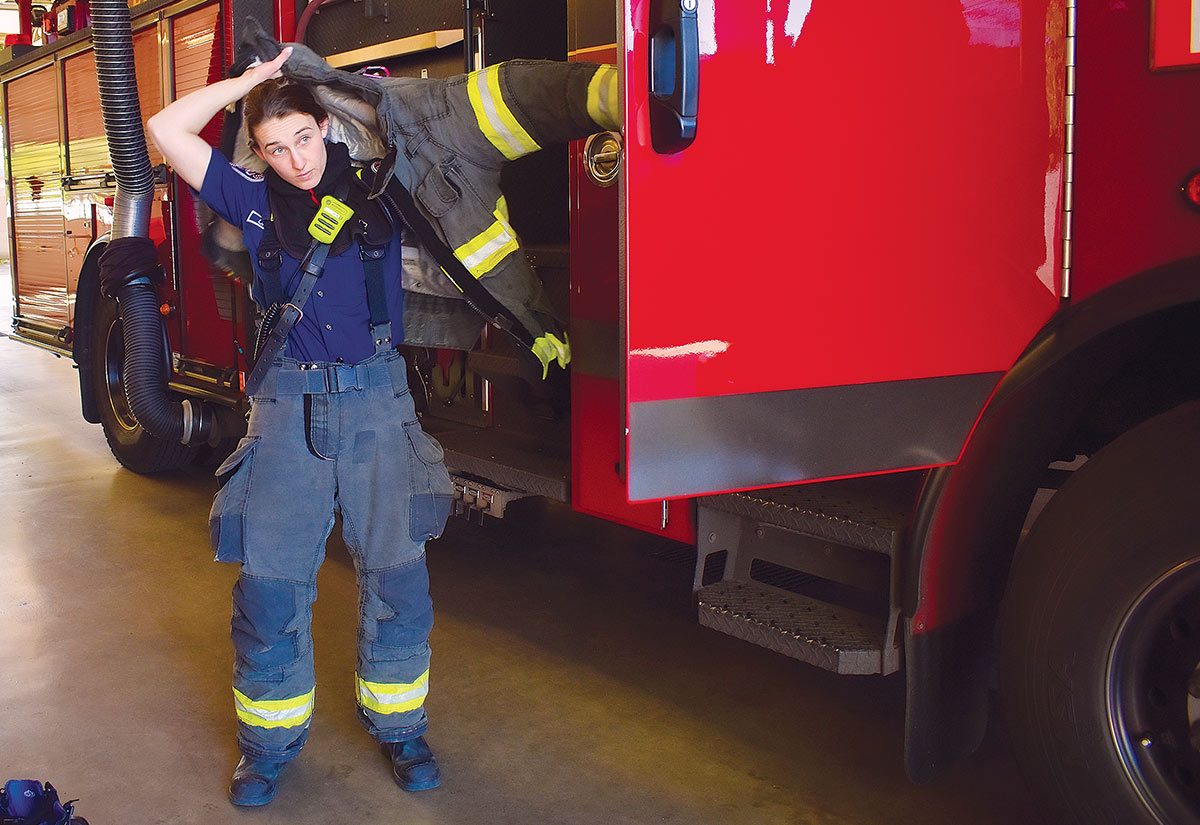“I have the best job in the world,” declares firefighter Claire O’Brien ’18. She was hired by the Renton Regional Fire Authority outside of Seattle in 2021.
Perils
and
Privilege
Med-school bound, Claire O’Brien ’18 felt a call to serve as a firefighter. The change in career plans led to her dream job.
photos by Katie Lewis
ou never get over the feeling of riding around in that shiny red truck,” says firefighter Claire O’Brien ’18. But it’s not all smiling and waving and handing out stickers to children. With all of the attendant challenges and perils, O’Brien loves being able to put her training into action to help people “on their worst day.”
Over 200 years have passed since Molly Williams, the first female firefighter (and also the first documented Black firefighter in the U.S.), made history. She proved the capacity of her gender by single-handedly pulling a pumper through the streets of Lower Manhattan in a blizzard to save lives and property when the rest of her crew had succumbed to influenza. But female firefighters are still few and far between.
Some girls have not seen female firefighters and don’t realize that a career in firefighting is an option. O’Brien, who was unwaveringly med school-bound when she graduated with a double major in biology and economics, was among them. While home in Seattle studying for the MCAT, she trained as an EMT and got to know some firefighters.
“I realized firefighting was something I had the physical and intellectual capacity to do,” says O’Brien, who began to think more deeply about what she wanted from a career. In addition to being able to serve her community in a real way as a firefighter, she loved the idea that physical fitness, lifelong learning, and the camaraderie of a close-knit team would all be part of the work. So she made the courageous decision to veer away from what she’d always said she would do.
She applied to be a career firefighter, accepted an offer with Renton Regional Fire Authority (RFA) outside Seattle, and began a grueling 20-week Fire Academy program. Through snow, sleet, and sunshine, she learned the lingo, the procedures, and everything from throwing a ladder to feeling her way through a blacked-out, smoke-filled building in search of victims.
“people trust us to come whenever they need us, whether it’s 3 p.m. or 3 a.m. people trust us to be knowledgeable and hardworking. ”
—claire o’brien ’18

After completing a grueling 20-week Fire Academy program, O’Brien is now a career firefighter with Renton Regional Fire Authority near Seattle.
“I’d think, ‘This is tough… but I can do it… I love it!’” she says. Now she declares unequivocally, “I have the best job in the world!”
Women comprise roughly 5% of career firefighters in the U.S., but Renton RFA is proud to have over double that national average on its team. Firefighters support one another through many difficult and risky situations, and O’Brien is grateful for her crew.
“There’s a sense of family,” she says. “We have dinner together every night on shift and talk, joke, debrief.” These are mentoring relationships, too, as more senior firefighters pass on their knowledge and experience — through informal conversations and in the heat of each new emergency.
There’s always more to learn, and O’Brien has achieved certification as a hazardous materials technician and completed Washington State Firefighters’ rigorous Joint Apprenticeship Training Committee program.
O’Brien describes going into a burning building as fun and exciting, and she likens working in high-stress scenarios — whether performing rescues in burning buildings or administering life-saving medical care to trauma patients — to solving puzzles. “At Swarthmore, I learned to critically analyze and solve problems with strategic thinking — to think of problems simply as puzzles,” she says. A clear head and resilient attitude are critical, and Swarthmore also taught her to appreciate that not everything good is easy.
“You have to have passion,” she says. “Firefighters face daily unknowns, including risking our lives, potentially getting cancer, injury, and mental challenges.”

“Whether you have a leak, a strange smell, a fire, crash your car, or your toe hurts — we come no matter what,” she says. O’Brien played four years of varsity soccer for the Garnet and has always enjoyed weightlifting and physical activity. While she relishes the physical demands of the work, they also present the biggest challenges for a 5-foot-5-inch, 140-pound female working with equipment designed for a 6 foot, 180-pound male.
“The gear weighs almost half as much as I do — and then you add a saw, an ax, maybe a body. But I never felt like I couldn’t do something,” she says. “It’s all about learning tactics and techniques for performing these tasks — as well as maintaining strength for longevity in this career.”
Alongside her crew, O’Brien focuses on structural firefighting in buildings as well as hazardous material mitigation. Other crews specialize in technical rescue, water rescue, and the ever-increasing area of wildland firefighting.
As the world changes, the fire service continues to adapt. “Electric vehicle fires, for example, are on the rise and present unique challenges, both in extinguishing the fire itself, as well as dealing with the toxic waste and gases produced,” O’Brien says. “We’re in discussion about the best ways to fight fires the world hasn’t seen.” Perhaps more than anything, O’Brien feels a sense of privilege.
“People trust us to come whenever they need us, whether it’s 3 p.m. or 3 a.m. People trust us to be knowledgeable and hardworking. They trust us to enter their homes in a state of panic or disarray. They trust us with their children and the elderly. Riding around in the fire engine feeling … like the luckiest person in the world to be in that seat, that’s when that sincere privilege can feel quite profound.”